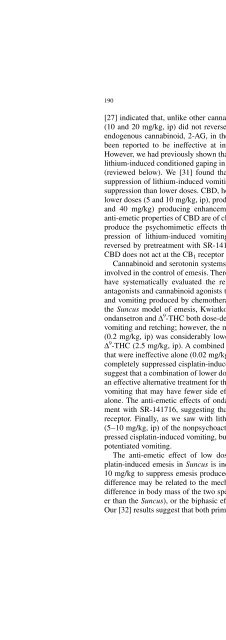3. Umbruch 4.4..2005 - Online Pot
3. Umbruch 4.4..2005 - Online Pot
3. Umbruch 4.4..2005 - Online Pot
You also want an ePaper? Increase the reach of your titles
YUMPU automatically turns print PDFs into web optimized ePapers that Google loves.
190 L.A. Parker et al.<br />
[27] indicated that, unlike other cannabinoids tested including ∆ 9 -THC, CBD<br />
(10 and 20 mg/kg, ip) did not reverse retching and vomiting induced by the<br />
endogenous cannabinoid, 2-AG, in the much smaller least shrew. It has also<br />
been reported to be ineffective at inhibiting gastric motility in mice [71].<br />
However, we had previously shown that CBD did prevent the establishment of<br />
lithium-induced conditioned gaping in rats [38], a putative rat model of nausea<br />
(reviewed below). We [31] found that ∆ 9 -THC produced a dose-dependent<br />
suppression of lithium-induced vomiting with higher doses producing greater<br />
suppression than lower doses. CBD, however, produced a biphasic effect with<br />
lower doses (5 and 10 mg/kg, ip), producing suppression and higher doses (20<br />
and 40 mg/kg) producing enhancement of lithium-induced vomiting. The<br />
anti-emetic properties of CBD are of clinical relevance, because CBD does not<br />
produce the psychomimetic effects that are produced by ∆ 9 -THC. The suppression<br />
of lithium-induced vomiting by ∆ 9 -THC, but not by CBD, was<br />
reversed by pretreatment with SR-141716, confirming previous findings that<br />
CBD does not act at the CB 1 receptor [61].<br />
Cannabinoid and serotonin systems interact centrally and both systems are<br />
involved in the control of emesis. There have been no studies with humans that<br />
have systematically evaluated the relative effectiveness of 5-HT 3 receptor<br />
antagonists and cannabinoid agonists to suppress acute and/or delayed nausea<br />
and vomiting produced by chemotherapeutic agents, such as cisplatin. Using<br />
the Suncus model of emesis, Kwiatkowska et al. [32] found that ip-injected<br />
ondansetron and ∆ 9 -THC both dose-dependently suppressed cisplatin-induced<br />
vomiting and retching; however, the minimally effective dose of ondansetron<br />
(0.2 mg/kg, ip) was considerably lower than the minimally effective dose of<br />
∆ 9 -THC (2.5 mg/kg, ip). A combined pretreatment of doses of the two drugs<br />
that were ineffective alone (0.02 mg/kg ondansetron and 1.25 mg/kg ∆ 9 -THC)<br />
completely suppressed cisplatin-induced vomiting and retching. These results<br />
suggest that a combination of lower doses of ondansetron and ∆ 9 -THC may be<br />
an effective alternative treatment for the acute phase of chemotherapy-induced<br />
vomiting that may have fewer side effects than higher doses of either agent<br />
alone. The anti-emetic effects of ondansetron were not affected by pretreatment<br />
with SR-141716, suggesting that ondansetron does not act at the CB 1<br />
receptor. Finally, as we saw with lithium-induced vomiting [31], low doses<br />
(5–10 mg/kg, ip) of the nonpsychoactive cannabinoid, CBD, effectively suppressed<br />
cisplatin-induced vomiting, but high doses of CBD (20–40 mg/kg, ip)<br />
potentiated vomiting.<br />
The anti-emetic effect of low doses of CBD against lithium- and cisplatin-induced<br />
emesis in Suncus is inconsistent with the failure of a dose of<br />
10 mg/kg to suppress emesis produced by 2-AG in the least shrew [27]. The<br />
difference may be related to the mechanism of action of the emetogens, the<br />
difference in body mass of the two species (the least shrew is 10 times smaller<br />
than the Suncus), or the biphasic effects of CBD on toxin-induced emesis.<br />
Our [32] results suggest that both primary cannabinoids found in cannabis, the







